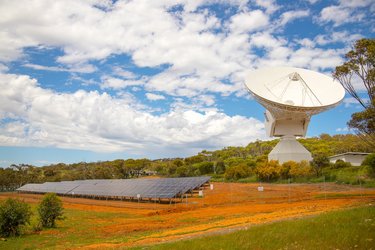Accept all cookies Accept only essential cookies See our Cookie Notice

About ESA
The European Space Agency (ESA) is Europe’s gateway to space. Its mission is to shape the development of Europe’s space capability and ensure that investment in space continues to deliver benefits to the citizens of Europe and the world.
Highlights
ESA - United space in Europe
This is ESA ESA facts Member States & Cooperating States Funding Director General Top management For Member State Delegations European vision European Space Policy ESA & EU Responsibility & Sustainability Annual Report Calendar of meetings Corporate newsEstablishments & sites
ESA Headquarters ESA ESTEC ESA ESOC ESA ESRIN ESA EAC ESA ESAC Europe's Spaceport ESA ESEC ESA ECSAT Brussels Office Washington OfficeWorking with ESA
Business with ESA ESA Commercialisation Gateway Law at ESA Careers Cyber resilience at ESA IT at ESA Newsroom Partnerships Merchandising Licence Education Open Space Innovation Platform Integrity and Reporting Administrative Tribunal Health and SafetyMore about ESA
History ESA Historical Archives Exhibitions Publications Art & Culture ESA Merchandise Kids Diversity ESA Brand Centre ESA ChampionsLatest
Space in Member States
Find out more about space activities in our 22 Member States, and understand how ESA works together with their national agencies, institutions and organisations.
Science & Exploration
Exploring our Solar System and unlocking the secrets of the Universe
Go to topicAstronauts
Missions
Juice Euclid Webb Solar Orbiter BepiColombo Gaia ExoMars Cheops Exoplanet missions More missionsActivities
International Space Station Orion service module Gateway Concordia Caves & Pangaea BenefitsLatest
Space Safety
Protecting life and infrastructure on Earth and in orbit
Go to topicAsteroids
Asteroids and Planetary Defence Asteroid danger explained Flyeye telescope: asteroid detection Hera mission: asteroid deflection Near-Earth Object Coordination CentreSpace junk
About space debris Space debris by the numbers Space Environment Report In space refuelling, refurbishing and removingSafety from space
Clean Space ecodesign Zero Debris Technologies Space for Earth Supporting Sustainable DevelopmentLatest
Applications
Using space to benefit citizens and meet future challenges on Earth
Go to topicObserving the Earth
Observing the Earth Future EO Copernicus Meteorology Space for our climate Satellite missionsCommercialisation
ESA Commercialisation Gateway Open Space Innovation Platform Business Incubation ESA Space SolutionsLatest
Enabling & Support
Making space accessible and developing the technologies for the future
Go to topicBuilding missions
Space Engineering and Technology Test centre Laboratories Concurrent Design Facility Preparing for the future Shaping the Future Discovery and Preparation Advanced Concepts TeamSpace transportation
Space Transportation Ariane Vega Space Rider Future space transportation Boost! Europe's Spaceport Launches from Europe's Spaceport from 2012Latest

Azores islands
Thank you for liking
You have already liked this page, you can only like it once!
This Sentinel-1A radar image was processed to depict water in blue and land in earthen colours. It features some of the Azore islands about 1600 km west of Lisbon, including the turtle-shaped Faial, the dagger-like Sao Jorge and Pico Island, with Mount Pico reaching over 2351 m in height.
The image highlights the differences in the relief of the islands, with volcanoes and mountains clearly standing out.
Faial is part of the central group of the Azores. The surface area covers 173 sq km. It has some 15 000 inhabitants and its main municipal seat is the city of Horta. Different shades of blue decorate the houses, which divide the fields and line the roads, giving Faial the name ‘Blue Island’.
In the 18th century, the development of whale hunting brought whaling fleets to Horta. By the 19th century, Horta had become an important seaport and a layover for a large number of yachts crossing the Atlantic.
Along with other islands in the archipelago, Faial is of volcanic origin. In 1957, a big eruption about 1 km from the coast ejected large quantities of lava and ash, forming an islet that later became connected to Faial island by an isthmus.
Unique among the islands of Azores, São Jorge is uncharacteristically long and slender, and so susceptible to ocean erosion.
The island is 55 km in length, with a mountain range forming its backbone. At 1053 m, Pico da Esperança is its highest peak. The island has an area of 246 sq km, with an obvious difference in the relief between the western and eastern sections: the western coast is lined with cliffs, while the east is smoother. Similarly, the northern coast has sharp cliffs, while the southern side is less inclined.
The island’s 9500 residents have lived in relative isolation for many years. Disturbed only by seldom visits from the authorities, commercial boats from the local islands, or the occasional aristocrat who comes to contemplate the local scenery, life on São Jorge is very relaxed.
However, with the inauguration of its ports and the airport in 1982, commercial ventures have grown, especially exporting local cheese, animal husbandry, fisheries and a small craft industries.
Named after its imposing mountain, Pico Island is one of the most beautiful and underrated islands of the Azores. Its history was forged on whaling and wines. The famous Pico wines and the UNESCO world patrimony designated vineyards, as well as wooden boat building, are contemporary features of Pico.
Whale hunting gave way to a movement of study and observation of whales, dolphins and other sea mammals. Since volcanic eruptions ended 300 years ago, Pico is considered dormant, adding to the island’s mystery and making it a magnet for scientists.
Sentinel-1A has been in orbit since April 2014, monitoring the marine environment and mapping water and soil surfaces, among other major applications.
This image, also featured on the Earth from Space video programme, was captured on 16 March.
-
CREDIT
Copernicus Sentinel data (2015)/ESA -
LICENCE
CC BY-SA 3.0 IGO or ESA Standard Licence
(content can be used under either licence)














 Germany
Germany
 Austria
Austria
 Belgium
Belgium
 Denmark
Denmark
 Spain
Spain
 Estonia
Estonia
 Finland
Finland
 France
France
 Greece
Greece
 Hungary
Hungary
 Ireland
Ireland
 Italy
Italy
 Luxembourg
Luxembourg
 Norway
Norway
 The Netherlands
The Netherlands
 Poland
Poland
 Portugal
Portugal
 Czechia
Czechia
 Romania
Romania
 United Kingdom
United Kingdom
 Sweden
Sweden
 Switzerland
Switzerland

























